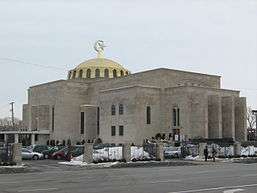Mosque Maryam
| Mosque Maryam | |
|---|---|
|
Mosque Maryam | |
| Basic information | |
| Location | 7351 S. Stony Island Avenue |
| Geographic coordinates | 41°45′39″N 87°35′6.2″W / 41.76083°N 87.585056°W |
| Affiliation | Nation of Islam (formerly Greek Orthodox) |
| Municipality | Chicago |
| State | Illinois, United States |
| Website | www.noi.org/ |
| Specifications | |
| Dome(s) | 1 |
| Minaret(s) | 0 |
| Part of a series on:
Nation of Islam |
|---|
 |
|
Subsidiaries |
|
Related organizations |
|
|
Mosque Maryam (Temple #2) in Chicago, Illinois, United States, is the headquarters of the Nation of Islam. It is at 7351 South Stony Island Avenue in the South Shore neighborhood.[1] Louis Farrakhan's headquarters are in the premises. The building was originally the Saints Constantine and Helen Greek Orthodox Church before that relocated to suburban Palos Hills. Elijah Muhammad purchased the building in 1972 and the mosque was then repurchased by Louis Farrakhan 16 years later, in 1988. It was named after Mary, the mother of Jesus ("Maryam" is Arabic for Mary).[1] Farrakhan said former Libyan leader Muammar Gaddafi had also lent Elijah Muhammad, his predecessor as head of the Nation of Islam, $3 million to convert a Greek Orthodox Church in Chicago into the Mosque Maryam.[2]
Design
The main prayer hall is unusual for mosque, since it was originally the church's nave that contained pews later replaced with seats.[3]
The distinctive architectural design of Mosque Maryam further identified the spiritual significance of this house. There are in the dome, placed in four directions, the Arabic phrase whose standard interpretation in English is "There is no god but God." In the centre of the dome is written "God is the greatest." Surrounding the dome in Arabic text is the 24th Sura (chapter), verses 35-40 of the Qur'an entitled, "Al-Nur (The Light)".
Mosque Maryam serves as the headquarters and National Center for the Nation of Islam. Adjacent to the mosque is Muhammad University of Islam, an educational institute for boys and girls from pre-school through 12th grade.
References
- 1 2 "Mosque Maryam and The Nation of Islam National Center." Nation of Islam. Retrieved on February 26, 2009.
- ↑ David Lepeska (April 9, 2011). "Farrakhan Using Libyan Crisis to Bolster His Nation of Islam". The New York Times. Retrieved July 8, 2015.
- ↑ Edward E. Curtis (2010). Encyclopedia of Muslim-American History. Infobase Publishing. p. 388. ISBN 978-1-4381-3040-8. Retrieved 16 December 2012.